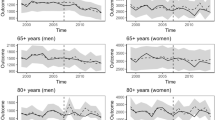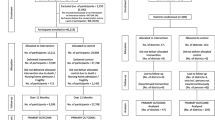Abstract
Associations between a 10-year community-based osteoporosis and fall prevention program and fracture incidence amongst middle-aged and elderly residents in an intervention community are studied, and comparisons are made with a control community. A health-education program was provided to all residents in the intervention community, which addressed dietary intake, physical activity, smoking habits and environmental risk factors for osteoporosis and falls. Both communities are small, semi-rural and situated in Östergötland County in southern Sweden. The analysis is based on incidences of forearm fractures in the population 40 years of age or older, and hip fractures in the population 50 years of age or older. Data for three 5-year periods (pre-, early and late intervention) are accumulated and compared. In the intervention community, forearm fracture incidence decreased in women. There are also tendencies towards decreasing forearm fracture incidence in men, and towards decreasing trochanteric hip fracture incidences in women and in men in the late intervention period. No such changes in fracture incidences are found in the control community. Cervical hip fracture incidence did not change in the intervention and the control communities. Although the reported numbers of fractures are small (a total of 451 forearm and 357 hip fractures), the numbers are based on total community populations and thus represent a true difference. The decrease in forearm fracture incidence among women, and the tendency towards decreasing trochanteric hip fractures, in contrast to the absence of change in cervical hip fractures, might be mainly due to a more rapid effect of fall preventive measures than an increase in bone strength in the population. For the younger age groups an expected time lag between intervention and effect might invalidate the short follow-up period for outcome measurements. Thus, the effect of the 10-year intervention program on fracture incidence should be followed during an extended post-intervention period.

Similar content being viewed by others
References
Cooper C, Campion G, Melton LJ III (1992) Hip fractures in the elderly: a world-wide projection. Osteoporos Int 2:285–289
Gullberg B, Johnell O, Kanis JA (1997) World-wide projections for hip fracture. Osteoporos Int 7:407–413
Ringertz H, and the working group of the Swedish Council on Technology Assessment in Health Care (SBU) (1995) Bone density measurement. Technical report 127 (in Swedish). Blomberg & Jansson Offsettryck, Stockholm
Löfman O, Berglund K, Larsson L, Toss G (2002) Changes in hip fracture epidemiology: redistribution between ages, genders and fracture types. Osteoporos Int 13:18–25
Svanström L (1990) Simply osteoporosis—or multifactorial genesis for the increasing incidence of fall injuries in the elderly? Scand J Soc Med 18:165–169
Lindqvist K, Timpka T, Schelp L (1996) Ten years of experience from a participatory community-based injury prevention program in Sweden. Public Health 110:339–346
Ytterstad B (1999) The Harstad injury prevention study: the characteristics and distribution of fractures amongst elders—an eight year study. J Circumpolar Health 58:84–95
Nilsson R, Löfman O, Berglund K, Larsson L, Toss G (1991) Increased hip-fracture incidence in the county of Östergötland, Sweden, 1940–1986, with forecasts up to the year 2000. An epidemiological study. Int J Epidemiol 20:1018–1024
Waller J, Angbratt M, Blomberg C, Kronhed AC, Larsson L, Löfman O, et al (1997) Logics and logistics of community intervention against osteoporosis. An evidence basis. J Med Syst 21: 33–47
Grahn Kronhed AC, Möller M (1998) Effects of physical exercise on bone mass, balance skill and aerobic capacity in women and men with low bone mineral density, after one year of training—a prospective study. Scand J Med Sci Sports 8:290–298
Söderström G (ed) (2000) 600 år i Vadstena. Vadstena stads historia från äldsta tider till år 2000 (in Swedish). Ekblad, Västervik
Michaëlsson K, Weiderpass E, Farahmand B.Y, Baron J.A, Persson P-G, Zidén L, Zetterberg C, Ljunghall S, and the Swedish Hip Fracture Study Group (1999) Differences in risk factor patterns between cervical and trochanteric hip fractures. Osteoporos Int 10:487–494
MapInfo(TM) (1992) Desktop mapping software: reference manual. New York
National Swedish Board of Health and Welfare IS (2001) Folkhälsorapport 2001 (in Swedish). Report No. 5. Modin-Tryck, Stockholm
Waller J, Eriksson O, Foldevi M, Grahn Kronhed AC, Larsson L, Löfman O, Toss G, Möller M (2002) Knowledge of osteoporosis in a Swedish municipality—a prospective study. Prev Med 34:485–491
Rose G (ed) (1992) The strategy of preventive medicine. Biddles, Guilford and King’s Lynn, Oxford
Puska P, Tuomilehto J, Nissinen A, Vartiainen E (1995) The North Karelia Project: 20 years results and experiences. National Public Health Institute (KTL), Helsinki
Luepker R, Murray DM, Jacobs DR Jr, et al (1994) Community education for cardiovascular disease prevention: risk factor changes in the Minnesota Heart Health Program. Am J Public Health 84:1383–1393
Johnell O (1998) Distal forearm and humerus fractures: events that reveal osteoporosis. In: Meunier P (ed) Osteoporosis: diagnosis and management. Martin Dunitz, London, pp 103–109
Parfitt A (1996) Skeletal heterogeneity and the purpose of bone remodelling. Implications for the understanding of osteoporosis. In: Marcus RFD, Kelsey J (eds) (1996) Osteoporosis. Academic Press, San Diego, pp 315–329
Gillespie L, Gillespie WJ, Robertson MC, Lamb SE, Rowe BH (2002) Interventions for preventing falls in elderly people. Report no. 1.The Cochrane Library
Acknowledgments
The financial support received for the study from the Östergötland County Council is gratefully acknowledged.
Author information
Authors and Affiliations
Corresponding author
Rights and permissions
About this article
Cite this article
Grahn Kronhed, AC., Blomberg, C., Karlsson, N. et al. Impact of a community-based osteoporosis and fall prevention program on fracture incidence. Osteoporos Int 16, 700–706 (2005). https://doi.org/10.1007/s00198-004-1732-0
Received:
Accepted:
Published:
Issue Date:
DOI: https://doi.org/10.1007/s00198-004-1732-0




